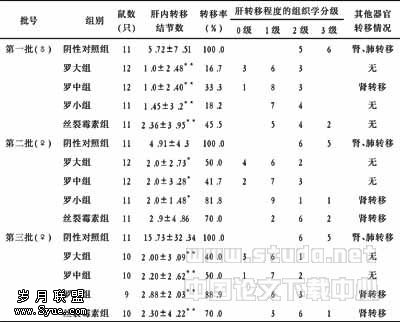细针穿刺肝脏孤立性坏死结节的临床病理特征
【摘要】 目的 研究B超下穿刺肝孤立性坏死结节的临床及病特点。方法 收集32例肝孤立性坏死结节的临床资料,并在光镜下观察其细针穿刺组织病理形态,同时复习相关。结果 本组男性21例,女性11例,平均年龄46.8岁,结节直径0.8~4.0 cm,临床及影像学缺少特异表现,光镜下结节中央为凝固性坏死,坏死外周围绕着一层弹力纤维及胶原组织,伴少数炎细胞浸润,结节周围的肝细胞基本正常。结论 肝孤立性坏死结节是一种少见的非肿瘤性结节状病变,对B超引导下穿刺标本进行组织病理学观察能够准确诊断。
【关键词】 肝;孤立性坏死结节;诊断;鉴别诊断
Abstract: Objective To study clinical and pathologic features of solitary necrotic nodule of the liver by fine needle aspiration biopsy.Methods We collected the clinical data of hepatic solitary necrotic nodule of 32 cases and observed their needle aspiration biopsy specimens by light microscope. Meanwhile, pertinent literature was reviewed. Results Of the 32 cases, 21 were males and 11 were females, with a mean age of 46.8 years. The diameter of the nodules was from 0.8 to 4 (cm). Their clinical and imaging features were not specific. Solitary necrotic nodules of the livers were composed of a central coagulation necrosis surrounded by a peripheral hyaline fibrotic capsule with a few of inflammatory cells. There were not obvious variances in the peripheral hepatocytes.Conclusion Solitary necrotic nodule of the liver is a rare nonneoplastic lesion of the liver. It is absolutely significant to diagnose solitary necrotic nodule of the liver by fine needle aspiration under the guidance of B?ultrasonic.
Key words: liver; solitary necrotic nodule; diagnosis; differential diagnosis
肝脏孤立性坏死结节是一种肝内良性结节状病变,由Shepherd和Lee 于1983年[1]首先提出,其相关报道至今不到50例[2],而国内经穿刺活检确诊的报道更为少见,我们对32例穿刺活检肝脏孤立性坏死结节的临床资料及病理学特征进行研究,该结节的临床病理特点,以提高人们的认识,对其提出病理诊断依据。
1 材料与方法
收集我院1998年10月—2007年2月间经病理确诊的肝脏孤立性坏死结节共32例,均为B超引导下肝细针穿刺活检标本。抽取1~4条病变,均经10%甲醛固定,石蜡包埋切片,HE染色,光镜观察。
2 结果
2.1 一般资料
本组年龄最大者74岁,最小者28岁,平均46.8岁,男女比例1:0.52。超声示例21病变呈强回声结节,例22呈等回声,其余均呈低回声结节,27例结节位于肝右叶,5例位于左叶,3例为多发结节,单个结节直径为0.8~4 cm。详见表1。表1 32例肝脏孤立性坏死结节患者临床资料(略)
2.2 病理检查
32例穿刺标本镜下病理形态基本相同,均含肝组织与病变交界区,结节中央为凝固性坏死区,坏死周围包绕着透明变性的纤维组织及胶原纤维,其中见少量炎细胞浸润,而纤维壳以外的肝细胞基本正常。表2显示本组32例病例镜下病理特征。
3 讨论
肝脏孤立性坏死结节为肝脏少见的非肿瘤性结节状病变[3]。国外文献[1~7]报道该病患者男性多见,年龄不<40岁,但也有仅为22岁的患者[8],说明该病也可发生于青年人。该结节无临床症状或症状不特异[9],往往是在体检、手术或尸检时偶然被发现[7]。本组仅有3例伴有明确的的肿瘤病史,而国外文献[10]统计50%的患者伴有肿瘤。孤立性坏死结节在影像上显示呈结节状,多位于肝被膜下,B超、CT示病灶多呈低回声或低密度结节, T1WI多呈低信号,T2WI呈低信号或高信号[8]。综合多种影像学检查结果对诊断确有一定的价值[11],本组术前有2例通过影像学考虑为肝孤立性坏死结节,但最终诊断还需病理检查[6]。表2 32例肝孤立性坏死结节病理特征(了)
3.1 病理特征
病变多位于肝右叶表面[1,3],肝的流入道附近[3],单结节多见,病灶直径多不超过4 cm,有个案报道直径可达8.5 cm[2]。镜下共同特征:结节中央为均匀一致的坏死性核心,嗜酸性,坏死物质周围包裹着透明变性的纤维组织及胶原纤维,少量炎细胞浸润,结节周围的肝细胞可基本正常。此外,一些学者[1,3]报道结节中含有钙化,Tsui等人[3]在坏死组织中还发现退变的细胞残骸、胆固醇裂隙及泡沫细胞,纤维壁内有一些内膜纤维化闭塞的小脉管,Berry[6]在结节坏死内发现明确的小血管结构。
3.2 病因和发病机制
关于肝孤立性坏死结节的具体病因还不明确,但可以认为其由多种病因导致的在临床及病理上基本相同的一种良性病变。Shepherd和Lee[1]发现孤立性坏死结节的病理特征和寄生虫感染很相似,另外,大多数病灶都位于肝的右叶表面,而右叶表面是肝最容易受到创伤的部位,从而认为结节可能来源于创伤或以前的慢性感染。然而Berry[6]在孤立性坏死结节内发现了“营养血管”的存在,认为该病变可能是代表了小血管瘤的最后硬化阶段,并报道未在其病例中找到寄生虫感染的迹象,后来Sundaresan等[12]也发现了“营养血管”的存在。1992年Tsui 等人[3]在所报道的病例中找到一条华支睾吸虫和一条寄生虫幼虫,而后Clouston等人[4]又在结节内发现一条线虫,从而认定该病变至少部分是因寄生虫感染导致的,其他病例由某些良性病变演化而来。肝孤立性坏死结节的发病机制具有多样性说法,要明确其发病机制还需进一步的研究和探讨。
3.3 鉴别诊断
穿刺活检应与伴有坏死的几种疾病相鉴别,常见的有转移癌[5]、肝脓肿、原发性肝肿瘤介入后的坏死结节等疾病。肿瘤的转移灶多为多结节,穿刺组织内可见异形的肿瘤细胞,孤立性坏死结节内无细胞或仅见细胞残骸。肝脓肿具有明显的感染症状,病变多灶,镜下见灶内大量脓细胞,而孤立性坏死结节的临床症状不明显,多为单结节,镜下为大量凝固性坏死。原发性肝肿瘤介入治疗后的坏死结节内除坏死组织外还含有剩余的肿瘤细胞,坏死周围多无纤维组织包裹,而透明变性的纤维带是诊断孤立性结节必不可少的依据。
由于肝孤立性坏死结节是一种良性病变,术前诊断非常重要,如果能在术前明确诊断就可采取局部切除或非手术治疗,避免不必要的创伤。需要指出的是手术切除标本病理诊断并不难,但对穿刺标本诊断时在镜下必需见到凝固性坏死、纤维带及基本正常的肝细胞,缺一不可。另外该结节也可多枚,正如Shepherd[13]后来所论述的把孤立性坏死结节改为“纤维性坏死结节”更为适合。
【】
[ 1] Shepherd N A, Lee G.Solitary necrotic nodules of the livers imulating hepatic metastases[J]. J Clin Pathol, 1983, 36 (10) : 1181-1183.
[ 2] Imura S,Miyake K,Ikemoto,et al.Rapidly?growing solitary necrotic nodule of the liver[J].J Med Invest,2006,53(3-4):325-329.
[ 3] Tsui W M, Yuen R W,Chow L T,et al. Solitary necrotic nodule of the liver[J]. J Clin Pathol,1992,45 (11):975-978.
[ 4] Clouston A D,Walker N I,Prociv P.Parasitic origin of a solitary necrotic nodule of the liver[J].J Clin Pathol,1993,46:578.
[ 5] Yoon K H,Yun K J, Lee J M, et al. Solitary necrotic nodules of the liver mimicking hepatic metastases: Report of two cases[J]. Korean J Radiol,2000,1:165-168.
[ 6] Berry C L. Solitary “necrotic nodule”of the liver: A probable pathogenesis[J]. J Clin Pathol,1985,198:1278-1280.
[ 7] Koea J,Taylor G,Miller M,et al. Solitary necrotic nodule of the liver:a riddle that is diffcult to answer[J]. J Gastrointest Surg,2003,7(5):627-630.
[ 8] Yoko E, Hiroshi H, Fjsu M, et al.A case of solitary necrotic nodule of the liver with acute liver dysfunction: the imaging appearance correlated with pathological findings[J]. Ultrasonics,2003,30(Autumn): 193-198.
[ 9] Nakanuma Y.Non?neoplastic nodular lesion in the liver[J]. Pathol Int,1995,45:703-714.
[10] De Luca M,Luigi B,Formisano C,et al. Solitary necrotic nodule of the liver misinterpreted as malignant lesion: considerations on two cases[J]. J Surg Oncol,2000,74(3):219-222.
[11] Colagrande S,Politi L S,Messerini L,et al. Solitary necrotic nodule of the liver:imaging and correlation with pathologic features[J]. Abdom Imaging,2003,28 (1):41- 44.
[12] Sundaresan M, Lyons B, Akosa A B.“Solitary” necrotic nodules of the liver: An aetiology reaffirmed[J]. Gut,1991,32:1378-1380.
[13] Shepherd N A.Solitary necrotic nodule[J]. J Clin Pathol,1990,43:348-349.











